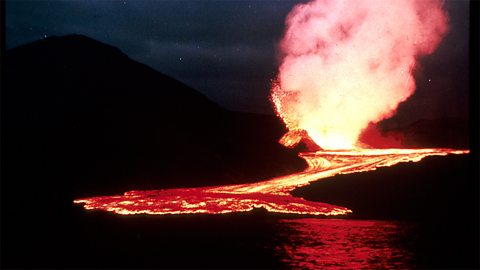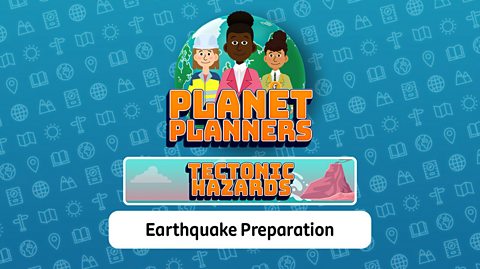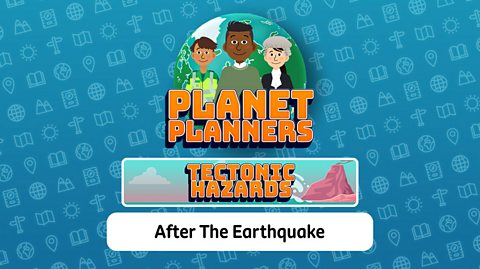What do you know?
What is a hazard?
A hazard is something which endangers life, property or the environment.
Key points
- There are a number of hazards caused by plate tectonics including earthquakes and tsunamis.
- Earthquakes have both primary effects (such as the destruction of buildings) and secondary effects (such as fires, water contamination, or spread of diseases) .
- There are ways of reducing the effects of earthquakes by, for example, planning, predicting and preparing.
Game - Earthquake preparation
Play a Planet Planners mission and help people to create plans to prepare for earthquakes.
You can also play the full game
Earthquakes
What is an earthquake?
An earthquake is a sudden, violent shaking of the ground. An earthquake occurs when two tectonic plateA section of the Earth’s crust, the outer shell of the Earth. push together. The pressure of these colliding plates builds up inside the Earth’s crust. The point in the crust where the pressure is released is called the focus. The point on the Earth's surface above the focus is called the epicentre. When the pressure is too much it is suddenly released and waves of energy, called seismic waveA wave of energy released by an earthquake., occur. These seismic waves travel through the earth causing it to shake.
Find out more about tectonic plates.
The shaking of the ground caused by an earthquake can cause a variety of effects. These can be classed as primary or secondary effects. Primary effects are caused by the earthquake itself, whereas the secondary effects are caused by the primary effects.
Primary effects
- Buildings may collapse due to the shaking of the ground.
- People may die if they are inside a building when it collapses.
- Roads may be blocked, gas and water pipes could be broken and electricity could be cut off.

Secondary effects
- The cost of rebuilding may be high.
- Trade will decrease, especially if the infrastructureThe parts of the built environment needed for a country to function such as roads, water and sewerage systems and ports; even schools and hospitals. (roads, airports etc) have been damaged.
- Spread of diseases may rise. If dead bodies are left in the open for a long period of time they can cause a risk of infectious diseases, such as tuberculosis and hepatitis B.
- Poor sanitation may occur if water pipes were broken during the earthquake.
Question
Is disruption to trade a primary or secondary effect?
Disruption to trade is a secondary effect as it is caused by the primary effect (damage to roads and infrastructure) rather than by the shaking of the earthquake itself.
Tsunamis
Video about the 2004 Asian tsunami
The causes and effects of the 2004 Asian tsunami
For 200 years, the tectonic plates under the Indian Ocean have been pushing against each other, bending the upper plate down like a giant spring. On the 26 December 2004, 20 miles below the ocean's surface, the forces reached breaking point. The fault starts to rupture. The western side of the mountain range on the edge of the plate is thrust up by as much as 40 feet.
At twice the speed of a bullet, the plates unzip over a distance of more than 750 miles, lifting the seabed - and the entire ocean above.
On the surface, the displaced water moves out as a series of giant ripples. This is a tsunami. Just a metre high, but a hundred miles from front to back, the tsunami is billions of tons of water travelling at over 500 mph.
From land, the first sign that something is wrong appears as the sea begins to pull back. This is the trough of the wave reaching land. The tsunami now goes through a terrifying transformation.
As it nears land, the shallow water slows the wave dramatically. But the back, a hundred miles behind, is still travelling fast. Now, it catches up, compressing the wave into a vertical wall of water up to 115 feet high.
It hits Banda Aceh with the force of sixty hurricanes, destroying everything in its path. 45 minutes later, at 9.30, a 60-foot wave crashes into Thailand. 30 minutes on, it engulfs the island of Phi Phi.
At the same time, on the other side of the ocean, the wave travelling west hits Sri Lanka. The tsunami's energy is so great, it travels around the world three times.
Earthquakes at sea cause water to be displaced, creating a fast-moving wave that spreads out in all directions. In the deep ocean, tsunami waves can reach speeds of up to 800 kilometres per hour. As the wave approaches shallower waters near to the shore, its speed will decrease but the waves will become higher.
These waves cause flooding and the majority of the deaths associated from tsunamis are caused by drowning. The flooding can contaminate water supplies and cause the destruction of homes.
The flooding can also lead to secondary effects such as causing illnesses in the area. These illnesses are due to poor sanitation and lack of clean water because of contaminated water supplies due to flooding. Flooding washes into clean water supplies carrying debris and sewage.
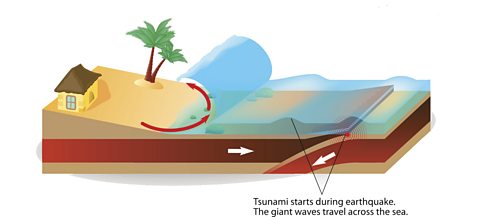
- A sudden shift in plate movement causes water displacement at the epicentre.
- Large waves move along the seabed away from the epicentre.
- As the waves move from deep water to shallow water near the coastal area, they increase in height and break.
 Image source, Getty Images 1133248925
Image source, Getty Images 1133248925Responses to earthquakes
After an earthquake the affected country must respond. Some responses will happen very quickly (immediate responses) and some may go on for months or years (long-term responses).
Immediate:
- People are rescued from destroyed buildings.
- People are evacuated.
- Emergency shelters are put in place.
Long-term:
- Reconstruction of destroyed buildings will take place.
- Infrastructure such as roads repaired.
- Temporary housing is provided.
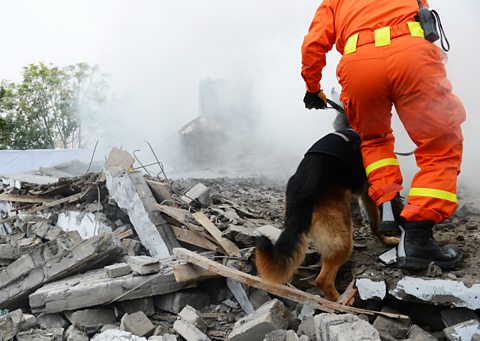 Image source, Getty Images 486476129
Image source, Getty Images 486476129Game - After the earthquake
Play a Planet Planners mission and help people to recover and rebuild after an earthquake.
You can also play the full game
Risk reduction
Countries can try to reduce the risk of damage from earthquakes by attempting to predict when they might occur, protecting their buildings to make them earthquake proof and preparing their population for what to do in the event of an earthquake.
Prediction
It is impossible to predict with certainty when an earthquake will happen but scientists can try in a number of ways. Using historical records GPSGlobal Positioning System. A navigation system using satellites. and seismographA scientific instrument that measures vibrations in the Earth including earthquakes. to measure small tremors scientists can predict where they believe earthquakes will occur. There has been some evidence that monitoring changes in animal behaviour could be a way to predict imminent earthquakes and seismologistA scientist who studies earthquakes. in China have monitoring stations in zoos for this reason.
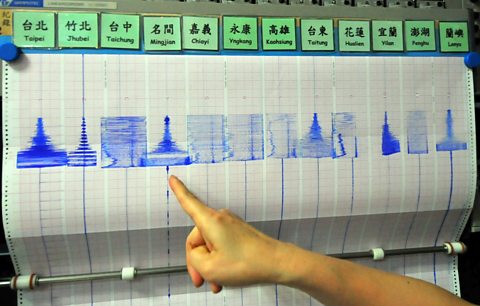
Protection
The most effective way to reduce risks is earthquake protection. Buildings can be constructed to resist the shaking associated with earthquakes. This can be done with counterweightA weight that, by applying an opposite force, provides balance. that correct the movement of the building and cross-bracingA system used to reinforce buildings in which diagonal supports are placed in a cross shape. to reinforce the structure, as shown in the image below.
Preparation
By training people what to do in the event of an earthquake, countries can increase the chances of survival in the event of an earthquake. This can be in the form of earthquake drills in schools or training emergency services on how to respond.
Question
Rescuing people trapped in a collapsed building is an example of what?
Rescuing people trapped in a collapsed building is an example of an immediate response.
How earthquakes impact countries
Natural hazards, such as earthquakes, can cause more damage in low income countries (LICs)Countries recognised by the World Bank as having a lower income than other countries. This classification is reviewed yearly. (LICs) than in high income countries (HICs)Countries recognised by the World Bank as being wealthier. This classification is reviewed yearly. (HICs).
HICs may have invested money and training into preparing the citizens of a country in evacuation methods, as well as increasing the stability of buildings and being able to invest in earthquake precautions when constructing new buildings.
However, LICs are less likely to have the money and resources to prepare for these natural hazards. Therefore when the hazard strikes, they are greatly affected. An example of this is the 2010 Haiti Earthquake that killed over 200,000 people, largely due to weak buildings collapsing.
Test your knowledge
Play the Planet Planners game! gamePlay the Planet Planners game!
Make decisions for the planet in this KS3 geography game.

More on Natural Hazards
Find out more by working through a topic
- count1 of 3
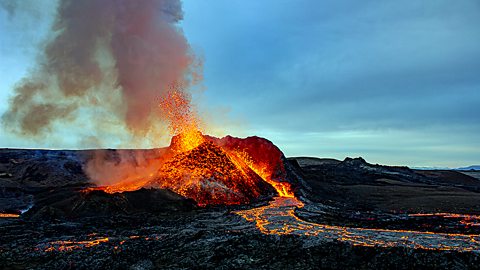
- count2 of 3
